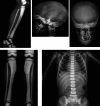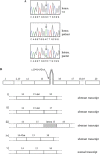As little as needed: the extraordinary case of a mild recessive osteopetrosis owing to a novel splicing hypomorphic mutation in the TCIRG1 gene
- PMID: 24535816
- PMCID: PMC4258090
- DOI: 10.1002/jbmr.2203
As little as needed: the extraordinary case of a mild recessive osteopetrosis owing to a novel splicing hypomorphic mutation in the TCIRG1 gene
Abstract
Mutations in the TCIRG1 gene, coding for a subunit of the osteoclast proton pump, are responsible for more than 50% of cases of human malignant autosomal recessive osteopetrosis (ARO), a rare inherited bone disease with increased bone density owing to a failure in bone resorption. A wide variety of mutations has been described, including missense, nonsense, small deletions/insertions, splice-site mutations, and large genomic deletions, all leading to a similar severe presentation. So far, to the best of our knowledge, no report of a mild phenotype owing to recessive TCIRG1 mutations is present neither in our series of more than 100 TCIRG1-dependent ARO patients nor in the literature. Here we describe an 8-year-old patient referred to us with a clinical diagnosis of ARO, based on radiological findings; of note, no neurological or hematological defects were present in this girl. Surprisingly, we identified a novel nucleotide change in intron 15 of the TCIRG1 gene at the homozygous state, leading to the production of multiple aberrant transcripts, but also, more importantly, of a limited amount of the normal transcript. Our results show that a low level of normal TCIRG1 protein can dampen the clinical presentation of TCIRG1-dependent ARO. On this basis, a small amount of protein might be sufficient to rescue, at least partially, the severe ARO phenotype, and this is particularly important when gene therapy approaches are considered. In addition, we would also recommend that the TCIRG1 gene be included in the molecular diagnosis of mild forms of human ARO.
Keywords: AUTOSOMAL RECESSIVE OSTEOPETROSIS; HYPOMORPHIC MUTATION; SPLICING DEFECT; TCIRG1.
© 2014 American Society for Bone and Mineral Research.
Figures


Similar articles
-
Novel mutations of TCIRG1 cause a malignant and mild phenotype of autosomal recessive osteopetrosis (ARO) in four Chinese families.Acta Pharmacol Sin. 2017 Nov;38(11):1456-1465. doi: 10.1038/aps.2017.108. Epub 2017 Aug 17. Acta Pharmacol Sin. 2017. PMID: 28816234 Free PMC article.
-
Novel c.G630A TCIRG1 mutation causes aberrant splicing resulting in an unusually mild form of autosomal recessive osteopetrosis.J Cell Biochem. 2019 Oct;120(10):17180-17193. doi: 10.1002/jcb.28979. Epub 2019 May 20. J Cell Biochem. 2019. PMID: 31111556
-
Buried in the Middle but Guilty: Intronic Mutations in the TCIRG1 Gene Cause Human Autosomal Recessive Osteopetrosis.J Bone Miner Res. 2015 Oct;30(10):1814-21. doi: 10.1002/jbmr.2517. Epub 2015 May 21. J Bone Miner Res. 2015. PMID: 25829125
-
Rare gross deletion in T-cell immune regulator-1 gene in Iranian family with infantile malignant osteopetrosis.Saudi Med J. 2008 Oct;29(10):1494-6. Saudi Med J. 2008. PMID: 18946580 Review.
-
Infantile malignant, autosomal recessive osteopetrosis: the rich and the poor.Calcif Tissue Int. 2009 Jan;84(1):1-12. doi: 10.1007/s00223-008-9196-4. Epub 2008 Dec 12. Calcif Tissue Int. 2009. PMID: 19082854 Review.
Cited by
-
Novel Disease-Associated Missense Single-Nucleotide Polymorphisms Variants Predication by Algorithms Tools and Molecular Dynamics Simulation of Human TCIRG1 Gene Causing Congenital Neutropenia and Osteopetrosis.Front Mol Biosci. 2022 Apr 28;9:879875. doi: 10.3389/fmolb.2022.879875. eCollection 2022. Front Mol Biosci. 2022. PMID: 35573728 Free PMC article.
-
Clinical and molecular characterization of five Chinese patients with autosomal recessive osteopetrosis.Mol Genet Genomic Med. 2021 Nov;9(11):e1815. doi: 10.1002/mgg3.1815. Epub 2021 Sep 21. Mol Genet Genomic Med. 2021. PMID: 34545712 Free PMC article.
-
Novel mutations of TCIRG1 cause a malignant and mild phenotype of autosomal recessive osteopetrosis (ARO) in four Chinese families.Acta Pharmacol Sin. 2017 Nov;38(11):1456-1465. doi: 10.1038/aps.2017.108. Epub 2017 Aug 17. Acta Pharmacol Sin. 2017. PMID: 28816234 Free PMC article.
-
Generation of an immunodeficient mouse model of tcirg1-deficient autosomal recessive osteopetrosis.Bone Rep. 2020 Jan 7;12:100242. doi: 10.1016/j.bonr.2020.100242. eCollection 2020 Jun. Bone Rep. 2020. PMID: 31938717 Free PMC article.
-
One Disease, Many Genes: Implications for the Treatment of Osteopetroses.Front Endocrinol (Lausanne). 2019 Feb 19;10:85. doi: 10.3389/fendo.2019.00085. eCollection 2019. Front Endocrinol (Lausanne). 2019. PMID: 30837952 Free PMC article. Review.
References
-
- Sobacchi C, Schulz A, Coxon FP, Villa A, Helfrich MH. Osteopetrosis: genetics, treatment and new insights into osteoclast function. Nat Rev Endocrinol. 2013;9:522–36. - PubMed
-
- Frattini A, Orchard PJ, Sobacchi C, et al. Defects in TCIRG1 subunit of the vacuolar proton pump are responsible for a subset of human autosomal recessive osteopetrosis. Nat Genet. 2000;25:343–6. - PubMed
-
- Kornak U, Schulz A, Friedrich W, et al. Mutations in the a3 subunit of the vacuolar H(+)-ATPase cause infantile malignant osteopetrosis. Hum Mol Genet. 2000;9:2059–63. - PubMed
-
- Michigami T, Kageyama T, Satomura K, et al. Novel mutations in the a3 subunit of vacuolar H(+)-adenosine triphosphatase in a Japanese patient with infantile malignant osteopetrosis. Bone. 2002;30:436–9. - PubMed
-
- Sobacchi C, Frattini A, Orchard P, et al. The mutational spectrum of human malignant autosomal recessive osteopetrosis. Hum Mol Genet. 2001;10:1767–73. - PubMed
Publication types
MeSH terms
Substances
Grants and funding
LinkOut - more resources
Full Text Sources
Other Literature Sources
Molecular Biology Databases
Research Materials

